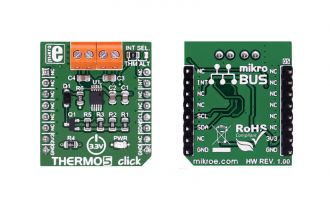
We strongly encourage users to use Package manager for sharing their code on Libstock website, because it boosts your efficiency and leaves the end user with no room for error. [more info]

Rating:
Author: MIKROE
Last Updated: 2019-03-13
Package Version: 1.0.0.1
mikroSDK Library: 1.0.0.0
Category: Temperature & humidity
Downloaded: 4936 times
Not followed.
License: MIT license
THERMO 5 click measures temperature in default range of 0°C to 127°C and extended range of -64°C to 191°C with ±1°C accuracy. It carries the EMC1414 temperature sensor. The click is designed to run on a 3.3V power supply.
Do you want to subscribe in order to receive notifications regarding "Thermo 5 click" changes.
Do you want to unsubscribe in order to stop receiving notifications regarding "Thermo 5 click" changes.
Do you want to report abuse regarding "Thermo 5 click".

Library Description
The library initializes and defines the I2C bus driver and drivers that offer a choice for writing and reading
data in and from registers. The library includes a functions for reading an internal diode, or any of 3 posible external diodes. User can also read device id, manufacturer id, revision version, therm limit, external diode fault, status register, low limit status, high limit status, get interrupt state, set and read : configuration, conversion rate, filter configuration and beta configuration settings for external 1 and 2 diodes Library also has generic read/write functions for additional read and write operations.
Key functions:
float thermo5_readExtern1Temp();- Function reads measurements made by external 1 diode.Examples description
The application is composed of three sections:
void applicationTask()
{
interTemp = thermo5_readInterTemp();
mikrobus_logWrite( " Internal temperature : ", _LOG_TEXT );
logDisplay( interTemp );
exterTemp1 = thermo5_readExtern1Temp();
mikrobus_logWrite( " External temperature 1 : ", _LOG_TEXT );
logDisplay( exterTemp1 );
exterTemp2 = thermo5_readExtern2Temp();
mikrobus_logWrite( " External temperature 2 : ", _LOG_TEXT );
logDisplay( exterTemp2 );
exterTemp3 = thermo5_readExtern3Temp();
mikrobus_logWrite( " External temperature 3 : ", _LOG_TEXT );
logDisplay( exterTemp3 );
mikrobus_logWrite( "---------------------------------", _LOG_LINE );
Delay_ms( 5000 );
}
Other mikroE Libraries used in the example:
I2CUARTConversionAdditional notes and informations
Depending on the development board you are using, you may need USB UART click, USB UART 2 click or RS232 click to connect to your PC, for development systems with no UART to USB interface available on the board. The terminal available in all MikroElektronika compilers, or any other terminal application of your choice, can be used to read the message